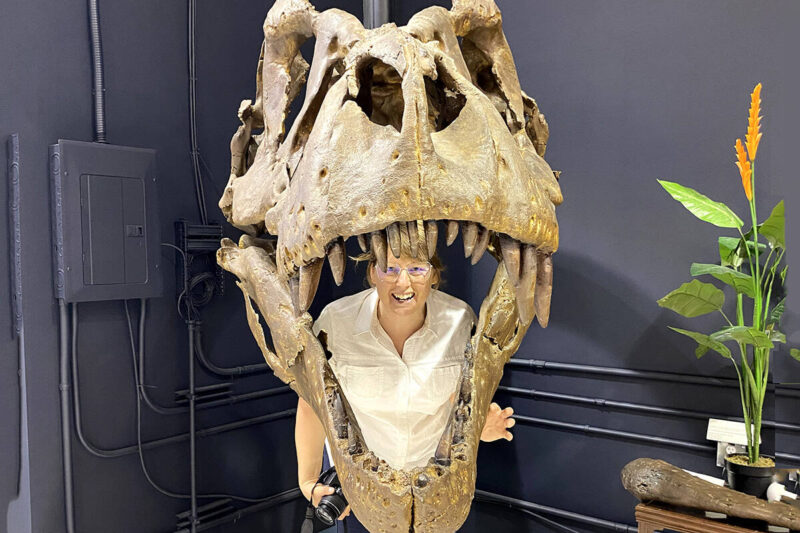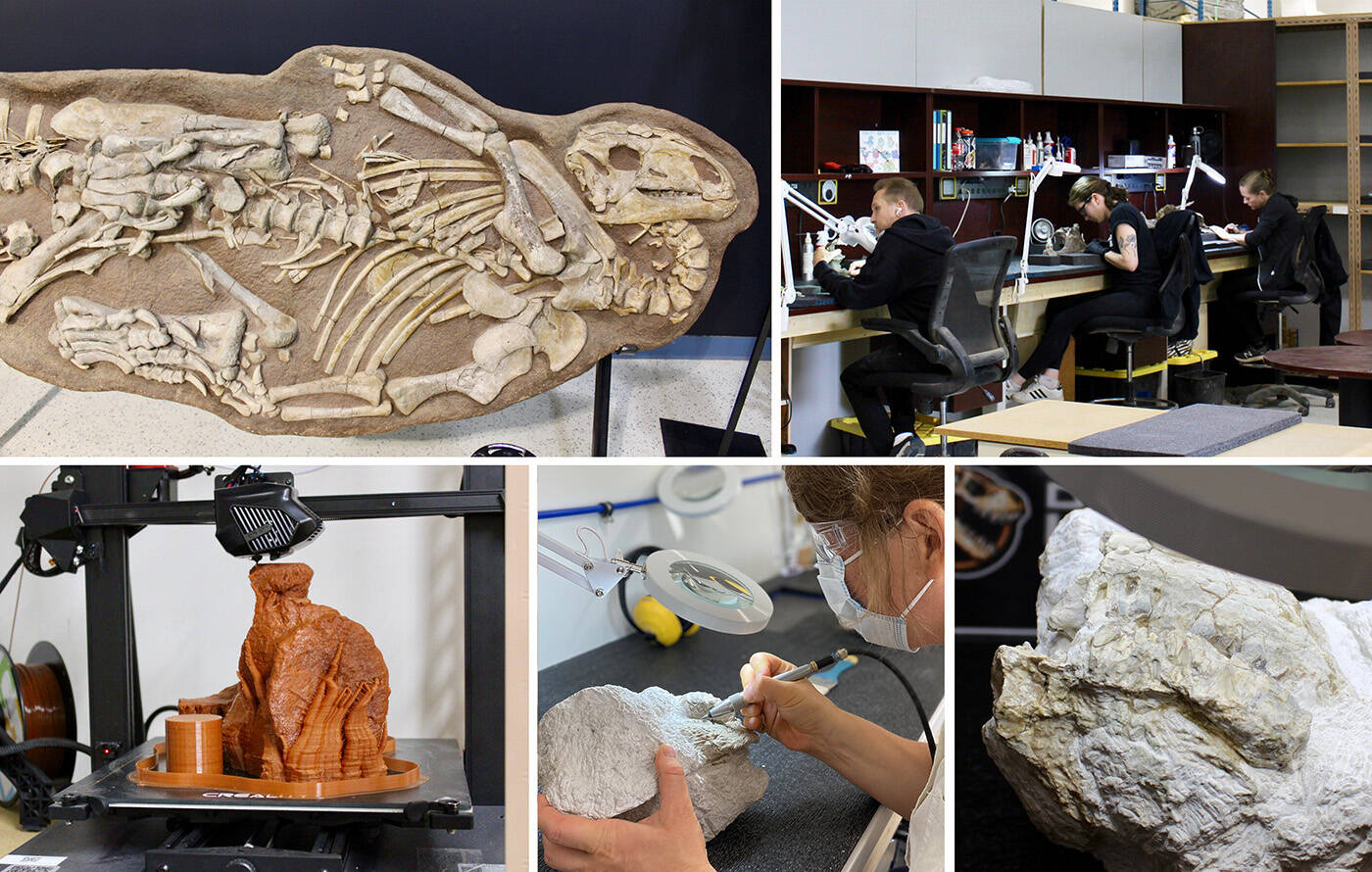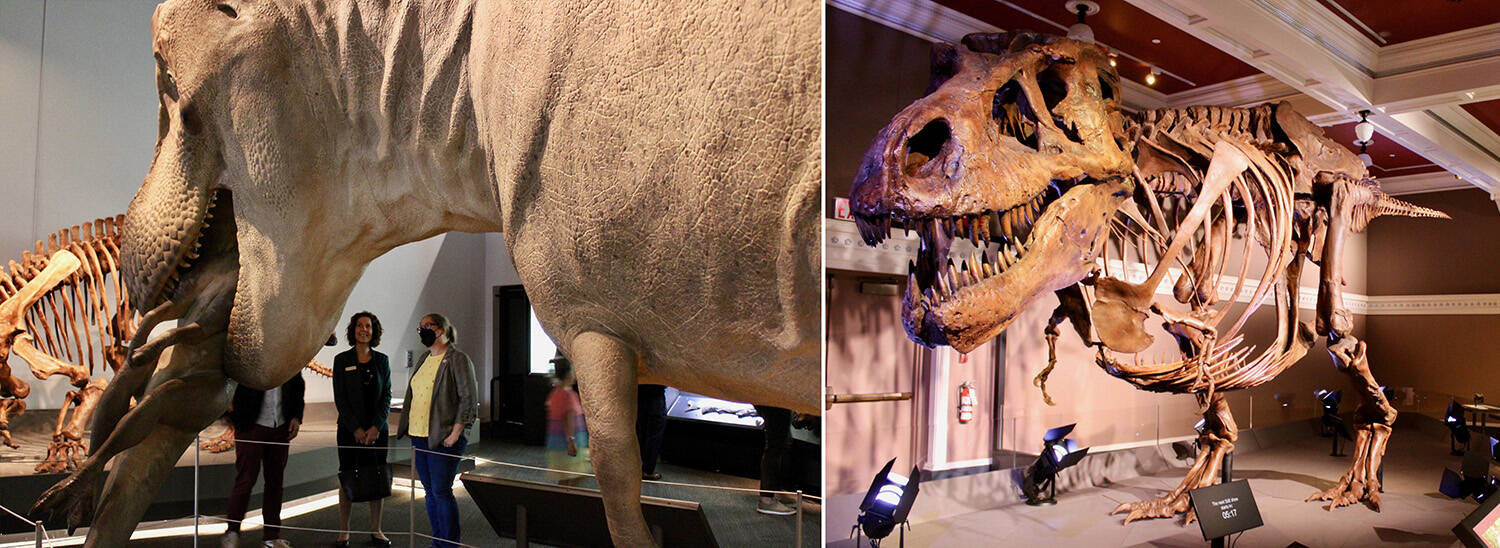Victoria the T. rex lived for about a year with a broken neck, but in the end it was a tooth ache that killed her.
Her fossilized legs show signs of broken bones and battle scars, and some of her neck vertebrae are fused — evidence of healing after major trauma. But the apex predator was able to survive, and hunt, despite those injuries.
“What actually ended up killing her was a dental abscess, likely from getting in a fight with another T. rex. That got infected to the point where she probably starved to death. It’s kind of sad — she’d gone through so much else, it ended up being dental care that did it,” says Carly Burbank, who co-owns and operates Dino Lab Inc. in Victoria, B.C., with Terry Ciotka.
READ MORE: Behind the scenes with a B.C. dino hunter, plus tips for finding fossils
Dino Lab is part educational destination, part restoration lab and part prehistoric boutique. They were in charge of restoring Victoria the T. rex about a decade ago, then shipped her off for a world tour of museums — but not before making a cast of her skull to keep on display. Visitors can see — and touch — the rugged features of her skull, and even step inside for a selfie.
“When we tell the story of Victoria’s tooth abscess to kids’ groups, we always finish with, ‘So brush your teeth, kids!’” Burbank laughs.
But Dino Lab isn’t just for kids. It’s one of the misconceptions they’re trying to modify within the world of palaeontology. Dinosaurs aren’t just for kids, and they’re not just for boys. Science isn’t just in textbooks — it’s exciting, hands-on and creative.
The lab is a hive of activity, even when tour groups aren’t passing through. A team of fossil restoration technicians use dental drills and brushes to clear rock and sediment away from fossils that are millions of years old. Welders and carpenters sculpt the support-systems for completed skeletons, which need to be both incredibly strong and incredibly gentle. In another room 3D printers buzz away, creating missing pieces for incomplete specimens.
READ MORE: West Coast Traveller RV Roadtrip: Drumheller, Alberta: The greatest show unearthed
But most notable for visitors — especially those used to the velvet ropes and glass cases of museums and art galleries — is the ability to get hands-on.
“I have an arts background, and when I’d go to see the stone carvings at museums in Europe I’d just want to touch them,” Burbank says.
At Dino Lab visitors can hold not just fossils but also a meteor from outer space, touch woolly mammoth hair, and even do their own fossil restoration work.
“We let visitors use the same tools we use. Staff go through everything with them, and show them the difference between matrix and fossil.”
With close supervision and a respectful clientele, they’ve yet to have any issues. Depending on the group, rare or delicate fossils may be kept behind glass, but most specimens are free to touch.
“It’s not doing anybody any good sitting in archive drawers, untouched and forgotten. Some of it needs to be protected, for sure, but for most things, as long as it’s supervised, there’s really very little people can do to hurt it,” Burbank says.
Dino Lab just moved into a larger space near Fisherman’s Wharf in downtown Victoria (their next restoration project is a Long Neck, so they needed more room). There’s also more space for birthday and stagette parties, date nights and visitors from the cruise ships docked a few blocks away.
Just down the road is the Royal BC Museum, which is having its own summer of dinosaurs. Dinosaurs of BC opened in April, featuring B.C.’s own Buster the ferrisaurus, and in June, SUE: The T. rex Experience moved in, featuring the most complete and best-preserved Tyrannosaurus rex found to date. In the same building, IMAX Victoria is hosting special screenings of Dinosaurs of Antarctica and Jurassic Park. The museum will also be hosting Dino Saturdays with activities for all ages.
“I’m so delighted that the Royal BC Museum is hosting SUE here this summer,” says the museum’s curator of palaeontology, Dr. Victoria Arbour. “Tyrannosaurus Rex is obviously one of the most iconic dinosaurs of all time and SUE is almost certainly the most famous of all known T. rex fossils — and maybe the most famous dinosaur ever.”
The exhibit offers many opportunities to get tactile with not just fossils but also the skin, and foul breath, of these prehistoric creatures. In addition to SUE’s actual fossil skeleton, there’s a life-sized (a.k.a enormous) model of SUE devouring a human-sized dinosaur, plus a triceratops skeleton to really make visitors feel small.
“Some might think that after nearly 120 years of studying T. rex, that scientists must know all there is to know about this animal. In reality, we know so little about the fossil animals that inhabited this earth, that year after year of study only sheds incremental light on these impressive creatures,” says Derek Larson, the museum’s collections manager and researcher in palaeontology.
Larson recently co-authored a paper which studied SUE and other therapods to determine if they had exposed teeth, like we see with crocodiles and in the movie Jurassic Park, or if their teeth were more covered, like the Komodo dragon.
“Our study overturns (the idea of exposed teeth) and seriously brings into question how we reconstruct what certain dinosaurs look like,” he says.
While the Royal BC Museum and Dino Lab offer slightly different perspectives on the study and celebration of dinosaurs, they’re not in competition. In fact, they work together to fight the real enemies: the high expense of excavation, the weather’s ability to destroy exposed specimens, and the drive to just build overtop of some fossils.
Field work, and transporting giant hunks of rock, is expensive. Restoration of a full specimen takes about two years. When a fossil is found, the first step is to find someone who can finance it. Sometimes that’s a museum, but often it’s a private owner.
“Often they’ll gift it to a museum,” Burbank says. Dino Lab did the restoration work for a T.rex named Tristan Otto, which is owned privately but is on display at Berlin’s natural history museum, which benefitted from increased ticket sales.
“The Tristan Otto agreement shows a way out of a dilemma much criticized by scientists – the purchase of fossils and artefacts by private individuals. With the purchase, many precious specimens become unavailable to research. Museums, on the other hand, do not have the means to cover the cost for salvaging and preparing such a find,” explains the Museum Für Naturkunde, Berlin. “Tristan Otto is an example of a solution to the problem. At the same time, all presentations and information that have been collected about the animal add to its value, in every sense of the word – a situation from which all benefit.”
Plan your dino day in Victoria
- The Royal BC Museum is open Sunday to Thursday 10 a.m. to 5 p.m., and 10 a.m. to 10 p.m. Friday and Saturday. The two dinosaur exhibits are included in the price of general admission. Both Dinosaurs of BC and SUE: The T.rex Experience will be in Victoria until Jan. 7, 2024.
- Dino Lab Inc. visits must be booked in advance. The Dinosaur Experience lasts approximately 90 minutes, and includes the opportunity to work on a real fossil. They also offer birthday parties for children and adults, plus other presentations and experiences.
Plan your adventures throughout the West Coast at westcoasttraveller.com and follow us on Facebook and Instagram @thewestcoasttraveller. And for the top West Coast Travel stories of the week delivered right to your inbox, sign up for our weekly Armchair Traveller newsletter!













 Silver Star wine festival returning in August
Silver Star wine festival returning in August